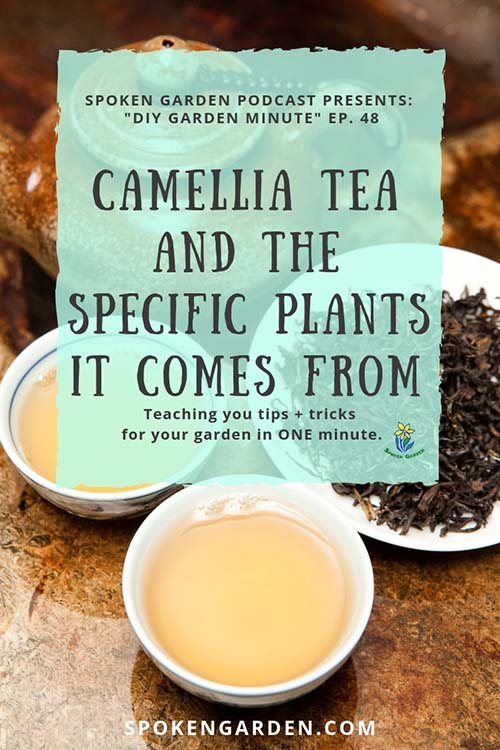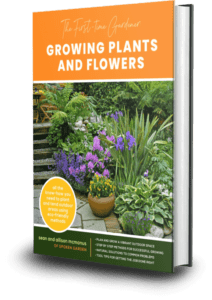Tea is good for you. Period.
Research indicates that drinking tea may lower your risk of heart attack and stroke because it contains antioxidants, among other things.
Ever wonder where your tea actually comes from?
What if we told you most of the tea produced around the world comes from two varieties of Camellia sinensis?
In our “Camellia Plant and Your Tasty Cup of Tea” we’ll teach you which varieties produce your tea and which specific types of tea are made this way.
This episode is meant for any level of gardener who wants to learn more about what the Camellia and its incredible uses.
Also, if you want to learn more about Camellia plant care in general, including its characteristics, colors, maintenance, and history, read our Camellia: A Gardener’s Guide and Plant Profile.
Types of Tea Plants
What is your favorite type of tea?
Black tea? Oolong? Green?
One specific species of Camellia is the main source for (most of) the tea you drink.
The species Camellia sinensis, specifically the varieties sinensis and assamica are the main source for Camellia leaf tea around the world.
These two Camellia varieties are responsible for:
-
- Black Tea,
- Yellow Tea,
- White Tea,
- Green Tea,
- Oolong Tea, and
- Dark Tea
Many generations of selective breeding have occurred to make the perfect tea leaves and the work continues.
To make each one of these teas, the leaves are processed differently to get that specific flavor or, as the tea experts say, oxidation.
To learn more about how tea leaves from the Camellia sinensis are used to process tea, read this article from the American Camellia Society.
Camellia Tea Episode Show Notes
Today’s topic is Camellia Tea Plants and Your Tasty Cup of Tea
The Camellia is a widely used and indispensable foundation plant in landscapes around the world for mostly shaded areas and for winter flower interest.
The species Camellia sinensis, specifically the varieties sinensis and assamica are the main source for Camellia tea around the world.
Listen to this podcast to learn more!
Also, as a reminder, you find us on your favorite podcast platform and now Alexa through MyPod or AnyPod!
See ya in the Garden!
And hey—before you head out—if you want to connect with us and subscribe to our newsletter go to Spoken Garden’s free resource page!
We have FREE garden content we are so excited to give to you, like cheat sheets, plant profile sheets, etc! See you there!
Thanks for Listening!!!
Share Your Thoughts:
- Leave a note in the comment section below.
- Leave comments/ suggestions at Seanandallison@eseospace.dev
- Share our show on Twitter, Facebook, or Pinterest.
To Help Out The Show:
- Leave a review on iTunes. Your ratings and reviews really help us out!
- Subscribe on iTunes or Spotify.

Click the graphic above to save “Camellia Tea Plant and Your Tasty Cup of Tea” to Pinterest for later!
*Spoken Garden is a participant in the Amazon Services LLC Associates Program, an affiliate advertising program designed to provide a means for sites to earn advertising fees by advertising and linking to Amazon.com.
Subscribe on iTunes
Today’s Topic:
Camellia Tea and Where It Comes From
Learn how Camellia sinensis is used for producing tea around the world.
Downloads:
Mulching Cheat Sheet Guide from our Free Resources Library
What You’ll Learn:
- The Camellia sinensis species and its two varieties used to produce most of the tea around the world.
- The specific types of tea created from these two varieties of Camellia sinensis.
Resources:
Some of the resources and products below may be affiliate links, meaning we might get paid a commission (at no extra cost to you) if you use that link to make a purchase.
- Camellia: A Gardener’s Guide and Plant Profile
- The Camellia Flower and Its 6 Delightful Shapes: DIY Garden Minute Ep. 47
- Best Pruning Shears For Any Gardener!
- DIY Garden Minute Ep. 30: Understanding Basic Plant Growth
Other Gardening Products Related To This Podcast You Might Not Have:
- Best pruning shears
- Loppers
- Hand saw:
folding or fixed
- Blower
: hand-held or backpack, gas or electric
- Leaf Rake
: metal or plastic
- Hard Rake
: metal


